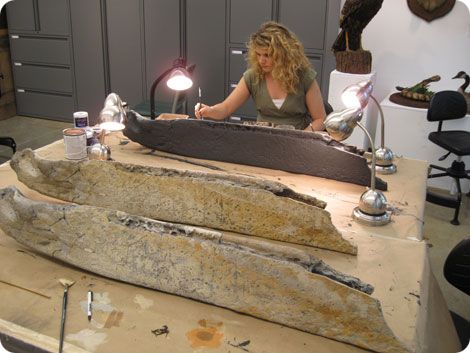Dodd Scientific Illustrators Give Whale Mandible New Life

Published
February 14, 2019
Categories
Faculty News
Student News
Tags
research
Academic Area
Scientific Illustration
Professor of Art and Area Chair for Scientific Illustration Gene Wright, along with Scientific Illustration Students Amy Sands (2011) and Amanda Camp (2012), constructed models and graphics of an extinct Atlantic Gray whale mandible that now have far reaching impact.
During the fall of 2006, Scott Noakes and other scientific divers from UGA and Gray’s Reef discovered what would soon be identified by scientists at the Smithsonian National Museum of Natural History (SNMNH) as an approximately 36,000 years old fossilized whale mandible.
This fragment belonged to an Atlantic Gray whale, a species that has been extinct since around 1740. Circumstantial evidence indicates whaling could have contributed to this population’s decline, as the increase in whaling activity in the 17th and 18th centuries coincided with the population’s disappearance. The Atlantic Gray whale mandible was approximately 20 miles offshore St. Catherine’s Island, Georgia. The mandible was mostly buried under an eroding scallop reef in approximately 70 ft water depth.
Once the bone fragment was recovered, it was sent to Emory University in Atlanta, Ga to be reconstructed with the assistance of both Emory University Students and Students from the University of Georgia. Because the mandible was seen a valuable tool for education, the SNMNH created a high-quality mold of the bone in 2010. This allowed researches to produce casts could be used for research and display in the future.
The SNMNH produced five resin casts with this mold. One remains on display at the SNMNH and three were sent to the University of Georgia to be painted. The SNMNH retained one cast for their research efforts on the now extinct Atlantic gray whales.
In 2011 the first of the mandible casts were painted by Gene Wright and Amy Sands. Sands completed this project as part of her senior thesis. Amanda Camp later painted a third mandible in preparation for a future display. These casts went on to be displayed in Smithsonian Museum of Natural History, Georgia Aquarium, and UGA Marine Extension Aquarium on Skidaway Island, Savannah, GA respectively.
These displays, along with the research of Scott Noakes, have been instrumental in educating the public on the relatively recent extinction of the Atlantic Gray whale. It is hoped that by informing the public about this once prevalent species, other whale species might be protected from extinction.
TIMELINE:
2006 the bone was discovered
2009 the preservation was performed at Emory University, Carlos Museum
2010 the mandible was on display in the fossil lab at the Smithsonian Museum of Natural History while they made the mold and 5 casts
2011 the first of the mandible casts were painted by Gene Wright and Amy Sands (senior thesis). Amanda Camp later painted a third mandible in preparation for display.
2011 a display was set up at the Georgia Aquarium using Amy Sands Cast
2014 a display was set up at the UGA Marine Extension Aquarium on Skidaway Island, Savannah, GA using Amanda Camps cast
2018 Wright’s cast was used during multiple presentations at the Smithsonian Museum of Natural History
2019 preparations are being made to display a cast at the Georgia Southern University Museum in Statesboro, GA





